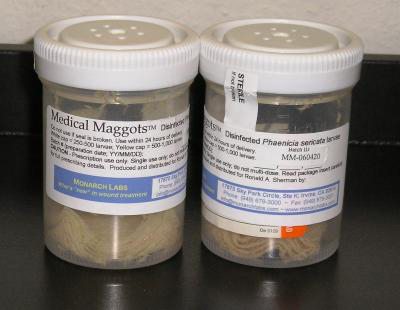Maggot Therapy Gains in Popularity

Maggots, the larval stage of certain flies, are already a federally approved treatment for people with nasty bed sores, chronic post-surgical wounds and diabetic foot ulcers.
Now, maggot therapy has received a boost from the medical establishment that could make it easier for patients and doctors to get insurance reimbursement for this treatment, which was noticed as effective against war wounds by Napoleon's surgeon general as well as by orthopedic surgeon Dr. William S. Baer during WWI, among others.
Today, specially prepared maggots, typically of the green bottle fly, are used to "debride" wounds, feeding on sick tissue so healthy cells can move in and further infection is avoided. Maggot therapy was common in the United States in the 1930s but was replaced by antibiotics in the following decade or so. Now, with the emergence of antibiotic-resistant bacteria including MRSA or methicillin-resistant Staphylococcus aureus, maggot therapy is getting a second look.
Not really eating
The new boost came last week when the American Medical Association and the Centers for Medicare and Medicaid Services clarified its reimbursement guidelines to the wound care community for medicinal maggots and maggot therapy, according to the BioTherapeutics, Education & Research (BTER) Foundation in California.
The BTER Foundation helps families without adequate health insurance to pay for medicinal maggots and other medicinal animals.
"Hopefully, more widespread acceptance and reimbursement by insurers will follow," BTER Foundation Director Dr. Ronald Sherman told LiveScience.
Sign up for the Live Science daily newsletter now
Get the world’s most fascinating discoveries delivered straight to your inbox.
Specially prepared maggots were cleared for marketing by the FDA in 2004 for treating neuropathic (i.e., diabetic) foot ulcers, pressure ulcers ("bed sores"), venous stasis ulcers, and traumatic and post-surgical wounds failing other forms of conventional therapy.
Juvenile larvae are used, because that is the stage of the animal that feeds on dead tissue. The maggots do not actually eat dead tissue in the way we think of it, nor is it specifically their "eating" that benefits the wound, Sherman said.
"They liquefy or dissolve the dead tissue (by secreting their digestive enzymes into the wound), so the wound is debrided [cleaned] whether the liquefied tissue and debris is eaten or simply drains out of the wound," he said. Larvae, being immature, are unable to reproduce in the wound, he added.
Maggots save insurance money
There are now more than 1,000 therapists using maggot therapy in the United States, Sherman said. A treatment supply of medicinal maggots costs less than $100, but can save thousands or even tens of thousands of dollars in medical, surgical and hospital costs.
"It's strange, but some insurance companies will pay tens of thousands of dollars for an amputation, probably because it is so common nowadays, but will hesitate or object to paying $100 for a course of maggot therapy," said Sherman, "even though studies repeatedly demonstrate that medicinal maggots have saved 40 to 50 percent of limbs otherwise scheduled for amputation due to non-healing wounds."
Sherman said dozens of maggot therapists and patients have been frustrated by their difficulties getting reimbursed by insurance companies and Medicare subcontractors for their maggot therapy expenses.
Sherman is also laboratory director for Monarch Labs (producer of the Medical Maggots™ brand of medicinal maggots), though he draws no salary from the lab or the BTER Foundation.
"I have long wondered why some insurance companies are not eager to pay for maggot therapy instead of more expensive medical or surgical wound care or amputations. After all, maggot therapy is effective, fast, and very inexpensive," Sherman said.
Medicare officials were sympathetic to requests for better coding and processing of insurance claims for maggot therapy, but they didn’t go so far last week as to provide specific codes for medical maggot products and maggot therapy procedures.
"Although they did not issue specific maggot therapy codes, they did now issue formal guidelines that describe how existing codes should be applied to maggot therapy and the maggot dressing materials," Sherman said.
"By doing this, we hope that insurers will recognize that medicinal maggots are not only cleared by FDA for marketing," he said, "but the therapy is accepted by AMA and Medicare as an appropriate treatment for many types of non-healing wounds."
- Video – The Dirt on Staying Clean
- Top 10 Mysterious Diseases
- Top 10 Mad Scientists
Robin Lloyd was a senior editor at Space.com and Live Science from 2007 to 2009. She holds a B.A. degree in sociology from Smith College and a Ph.D. and M.A. degree in sociology from the University of California at Santa Barbara. She is currently a freelance science writer based in New York City and a contributing editor at Scientific American, as well as an adjunct professor at New York University's Science, Health and Environmental Reporting Program.










